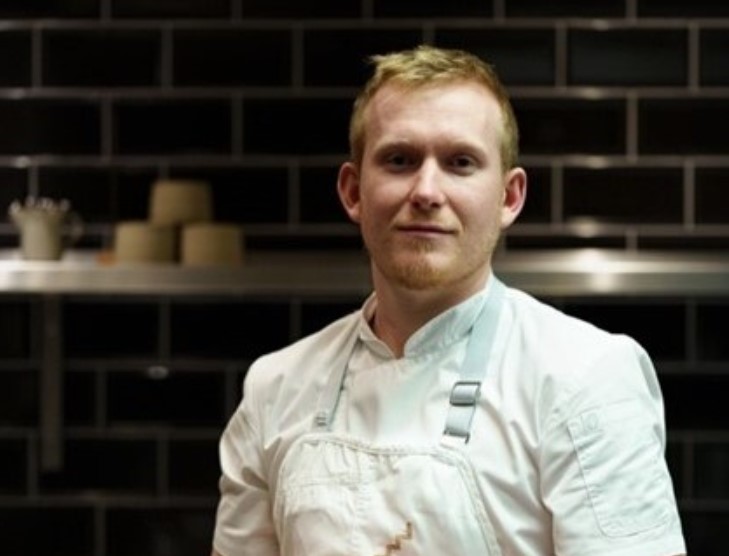Last Updated on October 18, 2024
Fine dining in the hills above Florence
Antonello Sardi is a well-respected name in Italian food circles, a self-taught chef who has garnered Michelin stars at Bottega del Buon Caffè in Florence and at Tenuta Le Tre Virtù in Mugello, plus a Green Michelin Green Star for sustainable cuisine. He has recently taken up residence at Serrae, a fine dining restaurant at Hotel Villa Fiesole in the hills above Florence. Seated on a terrace with the lights of the city twinkling in the distance, the moon rising, the early September evening warm and the jazz playlist mellow, I felt privileged to have been invited to review one of Sardi’s tasting menus. Having met the chef and his brigade briefly in his kitchen earlier in the day, my appetite was whetted for a special dinner and I can happily report that on a two-month trip through Italy, it is this meal at Serrae Villa Fiesole that comes out top with its reinterpretation of the traditional Tuscan menu.
On the cream linen tablecloth, simply set with a lamp and flowers in a glass vase, we found a folded card, sealed with the gold stamp of Serrae. Inside was a quote from Paul Eluard – everything that comes from my kitchen is grown in my heart – followed by a statement by Chef Sardi in which he lays out his philosophy and invites his diners to enjoy a sensual experience ‘guided by authentic imagination and rational creativity’.
Serrae offers diners an a la carte menu as well as several tasting menus. Wine pairings are offered and for once I felt regretful to be abstaining from alcohol as the list had an extensive range of Italian wines. My husband, who usually works through the wine pairing on my behalf, was unwell and unable to drink so the sommelier brought us a pair of mocktails: grapefruit, rose and orange and another of Crodino, apple juice and elderflower syrup. I love how Italians drink bitter aperitifs that make me reflect on the sometimes overly sweet profile of mocktails back home.
Our five-course menu was entitled Attualità, which translates as ‘actuality’. The menu noted that it encapsulates ‘ the savoir-faire of our small farmers and livestock farmers’.
The meal at Serrae Villa Fiesole began with a bouquet of grissini, hand-rolled by the chef. These were beautifully crunchy, pencil and deliciously long. Served in a white, textured, cylindrical vase, this traditional offering set the aesthetic tone for the rest of the evening.
Four small white dishes arrived each with a different shape, elevating the food on them to artworks on a plinth. A beetroot cloud with herbs and robiola cheese was first. The lightest beetroot-flavoured sponge with the robiola adding a deeply funky taste, that wonderful earthy flavour that this cheese imparts.


Second was a tiny tart with miso and tomato, mozzarella and a hemisphere of tomato and a micro herb. This interpretation of a caprese salad was sweet and deliciously delicate. Third was a tiny crispy flower with tiny dots of white. It was a veal paté, vegan mayonnaise with almond and apple jam. A wonderful interpretation of the traditional Tuscan chicken liver crostini. Finally, a wedge of focaccia stood proud on its white plinth, sculptural, accompanied by a green disk of basil butter that was shaped like a medallion one might wear around one’s neck. The herby butter was a lovely foil to the salty crust of the focaccia.
An amuse bouche was a ‘potato form’ with a mousse of vanilla, white chocolate, truffle, potato skin and potato from the mountains. The flavours were subtle and slowly the notes of truffle and the sweet flavour of white chocolate all came forward. It was a marvellous dish, as light as gossamer and looked beautiful in an organically shaped, white, stone bowl. Sardi uses truffle in a subtle manner which enhances the dish rather than overpowering it.
The bread courses was a welcome exception as while traditionally, Tuscan bread is made without salt, this was not of that ilk. Inside the bread were local flowers and seeds were strewn on top. It was served with a full-frontal, peppery extra virgin olive oil, a limited edition, local Fiesole blend. The bread bowl was sculpted like a large hand with fingers or gentle spikes holding the slices. The personality of the crockery always enhances the fine dining experience and I found this to be a particularly pleasing part of the meal.


The next course introduced a vegetarian dish – celeriac, green peppers, spinach Az. Agricola Arceri – Florence with talegio cheese, pine nuts and pumpkin seeds. On the base of the dish was the cheese, then the celeriac carpaccio, cream of pepperoni, cream of friggitelli (a green Italian pepper), pepperoni pesto with capers, pine nuts, and pumpkin seeds. There was so much going on here both visually and in the mouth. The celeriac carpaccio and the seeds and vegetables provided good textural contrast. There was a deeply flavoured essence of peppers that satisfied a need I didn’t realise my taste buds had. Even though the table was dimly lit, the vibrant red and green in this dish shone through. The dish was creamy at the base with the earthy notes of celeriac, married well with the sharp sweetness of the pepperoni pesto and the nuts and seeds. An excellent vegetarian creation.
At this point, a gloved waiter laid down a beautiful wood-handled knife and an attractively long fork. It suggested something special was about to arrive and it did. Glazed veal sweetbread, peaches and liquorice brought a dish of sweetbreads quite unlike any I have previously eaten, served with marinated peach. This dish was originally developed due to a mistaken delivery from the butcher who supplied heart rather than the usual throat sweetbreads. When Chef Sardi cooked the sweetbreads he was struck by the result and so a new dish was born. It was deeply satisfying, and meaty without being heavy. Tender as can be, served with the richest reduction and the heady flavour of marinated peach. The notes of liquorice added extra depth. Chef Sardi says that you have to love what you do, and in this dish, his love comes through loud and clear. He told me that he marinates the peach in a young, white vinegar from Modena.
The next course was a risotto of such excellence that I wanted to stop the meal just to sit and think about it. Then I wanted to eat it all over again. Tenuta San Carlo organic Carnaroli rice with Parmigiano Reggiano Dop aged 24 months, ‘caccuicco’ of Az. Agricola Arcenni – Capannoli (Pisa) snails, lemon, celery and herbs from our botanical garden. With a colour scheme of yellow, greens and black this risotto contained snails from Pisa, tiny cubes of marinated celery and lemon gel and Tuscan mint. Served with a 24-month-old aged cheese. Imagine if you will, a sweet and sour risotto, executed with great subtlety. There was excellent textural contrast between the crunchy celery, the perfect bite of the rice and the soft snails. Multiple levels of flavour were presented along with the potent cheese that did not overpower the other flavours which all shone through. The lemon balanced the richness of the cheese. I thought the lemon also referenced the location of the restaurant which was once a limoneto – a lemon grove. This was certainly the most creative risotto I have ever eaten.
The following course was zucchini ‘alla Scapece’, melting Pecorino cheese and tomato water. This is a dish that originates in the south of Italy. In the scapece method of preparation the zucchini is first fried and then marinated with vinegar, mint and almonds. Then the chef transformed it into a doughnut-shaped mousse. There was also a frittelina made with sautéed carrots and peppers encased in a green band of pasta. These were perched in a Pecorino fondue and served with tomato foam. The piquant mousse tasted like the essence of zucchini, was enclosed in a skin and decorated with micro herbs. This dish had shades of cream, green and tiny pops of red from the peppers and also – by association – from the tomato foam which was in fact white. This sophisticated dish with its combination of sharp and sweet flavours was balanced by bitter notes to cut through the rich cheese fondue. For anyone bored with their glut of zucchini – here is a dish to re-awaken interest in this versatile vegetable.
Brass-coloured cutlery arrived next for a pre-dessert served in a leaf-shaped bowl. This was a deconstructed apple tart with a disc of caramelised apple mousse spiced with cinnamon, Calvados and vanilla – cold and refreshing – on a base of Speculoos crumbs with lemon gel, and Tuscan mint. The biscuity texture of the Speculoos provided a backdrop to the cold apple mousse, while the lemon gel added its sharp note to balance the sweet flavour of the biscuit and fruit. Cinnamon brought warmth.
The dessert, Serrae’s zuccotto, was served in a beautiful white bowl veined with silver. Zuccotto is a traditional chilled Tuscan dessert, originating in Florence, and made with cake, ice cream and an Italian liqueur called Alkermes. In this interpretation, a base of Spanish bread was infused with sour cherries and Alkermes, a local liqueur from the Pharmacy of the Santa Maria Novella, a chocolate mousse, Chantilly cream with ricotta, a gel of marinated sour cherries and a crunchy tuille. It was presented with a quenelle of sour cherry on a chocolate crumble. In Florence, there is a remarkable shop called Officina Profuma-Farmaceutica di Santa Maria Novella. It is located within a chapel of the magnificent Chiesa de Santa Maria Novella and was once the world’s oldest pharmacy run by the Dominican friars who created herbal tinctures from the plants they grew. We visited this outlet of what is now a luxury brand the previous day and were delighted to find that their liqueur was used in this dessert.


A dish of petit fours was presented along with an espresso and a verbena tea. Baci di dame are very popular biscuits across Italy and Serrae makes its own version with a white chocolate ganache and pistachio. There was also a praline made with hazelnut, lemon and white chocolate. It sat on a crumb of dark chocolate, served inside a dish shaped like a cacao pod. Three other treats were perched on a large disc. A macaron with a ganache of white chocolate, redcurrant and lime was decorated with a gold strip. A raspberry gelée and a lollipop with milk chocolate and coconut.
The wine pairing that is suggested with this menu includes three wines. Franciacorta Berlucchi Rosè 61 Berlucchi DOC Pinot nero 70% Chardonnay 30%; Villa di Bagnolo Marchesi Pancrazi IGT Pinot nero 100%; Marsala Superiore Garibaldi Dolce Angileri DOC Grillo, Catarratto, Inzolia. The five-course menu is 99 euros with 59 euros for the wine pairing.
After service, Chef Sardi came around to meet and talk to his guests and was happy to answer any questions about the meal we had enjoyed. Serrae at Villa Fiesole is as far from the tourist-filled restaurants of Florence as you could wish to be. The cuisine is sophisticated, playful, creatively conceived and executed, and most of all, delicious. The staff are well trained and able to talk in detail about the food. They are smartly attired in navy suits and balance well the ability to engage with diners without being intrusive. They provide a smooth service with coordinated serving and removal of dishes, the sort of choreography one finds at Michelin-star restaurants. The five-course tasting menu was well-paced across two hours. There was also a seven and a nine-course menu as well as a four-course vegetarian menu on offer. Every dish had its own crockery, mostly in white with individual beauty. Serrae at Villa Fiesole has achieved a mention in the Michelin Guide with Chef Sardi having been at the helm for only a short while. Surely it cannot be long before a star is bestowed. If you are in Florence, I heartily recommend that you Book a table and take a taxi up into the hills for dinner. Even better, book to stay over at Hotel Villa Fiesole and make a night of it.
Serrae at Villa Fiesole,
Via Frà Giovanni da Fiesole Detto l’Angelico,
35, 50014 Fiesole
FIorence
Italy
Closed Tuesdays.










